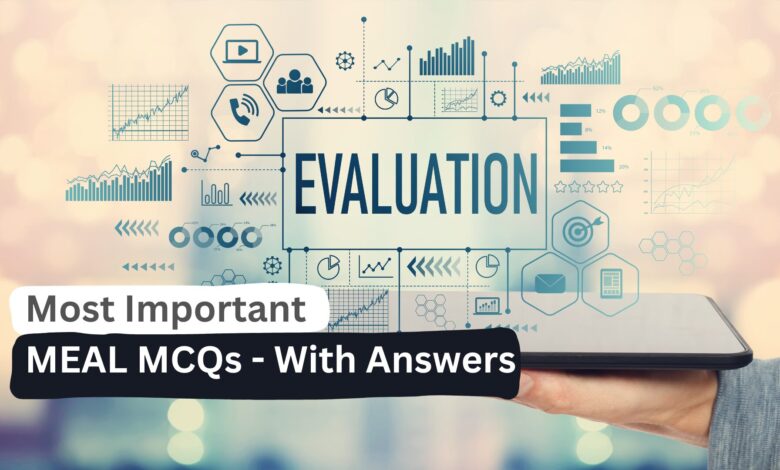Exams & Best Practices
Best 20 MCQs for MEAL Officer Position with Answers

What does MEAL stand for?
Monitoring, Evaluation, Accountability, and Learning (MEAL) plays a critical role in humanitarian and development projects. If you’re preparing for a MEAL officer position, practicing multiple-choice questions (MCQs) can help boost your understanding and test your knowledge. Below are the best 20 MCQs designed to give you a comprehensive review of the core concepts for a MEAL officer position, followed by answers at the end. Let’s discover the best MCQs for MEAL officer position.
- What does MEAL stand for?
a) Monitoring, Evaluation, Accountability, and Learning
b) Measurement, Evaluation, Assessment, and Learning
c) Management, Evaluation, Accountability, and Leadership
d) Monitoring, Evaluation, Assessment, and Leadership - Which of the following is a primary purpose of Monitoring in MEAL?
a) To identify potential stakeholders
b) To ensure project activities are on track
c) To create new policies
d) To allocate resources for future projects - Accountability in MEAL primarily refers to:
a) Ensuring that funds are spent correctly
b) Providing feedback mechanisms to beneficiaries and stakeholders
c) Evaluating project outcomes
d) Developing a project risk matrix - In the context of MEAL, Learning focuses on:
a) Increasing organizational knowledge for future projects
b) Ensuring compliance with donor requirements
c) Gathering data for research
d) Writing reports - Which of the following is the best example of an output indicator?
a) Number of trainings conducted
b) Increase in community income
c) Improved health outcomes
d) Reduction in child mortality - A logical framework (Logframe) is used primarily for:
a) Project design and tracking progress
b) Financial reporting
c) Stakeholder communication
d) Policy development - What is the key purpose of an evaluation in the MEAL process?
a) To track day-to-day activities
b) To assess the impact and effectiveness of a project
c) To create awareness among stakeholders
d) To design project goals - Which method is typically used for collecting qualitative data in MEAL?
a) Surveys
b) Focus group discussions
c) Statistical analysis
d) Budget forecasting - A “baseline study” in MEAL refers to:
a) A study conducted after project completion
b) A study conducted before the project begins to assess initial conditions
c) An interim evaluation during the project
d) A study to assess long-term impact - What does SMART stand for in the context of indicators?
a) Specific, Measurable, Achievable, Relevant, Time-bound
b) Strategic, Methodical, Accountable, Responsive, Transparent
c) Scalable, Meaningful, Actionable, Reliable, Testable
d) Simple, Measurable, Attainable, Reliable, Transparent
Did you enjoy our best MCQs for MEAL officer position till now? - In the MEAL framework, which of the following is an example of an outcome indicator?
a) Number of beneficiaries receiving aid
b) Percentage of households with improved water access
c) Number of workshops organized
d) Budget allocated for the project - What is a key advantage of participatory monitoring in MEAL?
a) It speeds up data collection
b) It ensures donor compliance
c) It involves beneficiaries in tracking progress
d) It reduces project costs - How often should a MEAL officer update the monitoring data?
a) Only at the end of the project
b) Quarterly
c) Annually
d) As frequently as needed, depending on project scope - Which of the following is a qualitative indicator?
a) Number of children enrolled in school
b) Percentage of households with access to clean water
c) Community perceptions of safety
d) Number of people trained - What is the primary focus of accountability in a MEAL system?
a) Ensuring project success
b) Monitoring project outputs
c) Addressing stakeholder feedback and transparency
d) Reducing project costs - Which tool is commonly used for quantitative data analysis in MEAL?
a) SPSS (Statistical Package for the Social Sciences)
b) NVivo
c) SWOT analysis
d) Stakeholder mapping - When conducting an evaluation, which of the following is considered best practice?
a) Only include project staff in the evaluation
b) Engage all stakeholders, including beneficiaries
c) Conduct it without a baseline for comparison
d) Focus solely on financial aspects - Which one of these is NOT a type of evaluation?
a) Formative evaluation
b) Summative evaluation
c) Participatory evaluation
d) Longitudinal evaluation - What is meant by “triangulation” in data collection?
a) Using only one source for data
b) Collecting data at three points in time
c) Using multiple methods and sources to validate data
d) Involving three stakeholders in data review - What is a key characteristic of a good indicator in MEAL?
a) It is difficult to measure
b) It is relevant to the project’s goals
c) It is subjective
d) It is donor-driven
Check another MCQs in Monitoring and Evaluation
Answers of Best MCQs for MEAL officer position
- a) Monitoring, Evaluation, Accountability, and Learning
- b) To ensure project activities are on track
- b) Providing feedback mechanisms to beneficiaries and stakeholders
- a) Increasing organizational knowledge for future projects
- a) Number of trainings conducted
- a) Project design and tracking progress
- b) To assess the impact and effectiveness of a project
- b) Focus group discussions
- b) A study conducted before the project begins to assess initial conditions
- a) Specific, Measurable, Achievable, Relevant, Time-bound
- b) Percentage of households with improved water access
- c) It involves beneficiaries in tracking progress
- d) As frequently as needed, depending on project scope
- c) Community perceptions of safety
- c) Addressing stakeholder feedback and transparency
- a) SPSS (Statistical Package for the Social Sciences)
- b) Engage all stakeholders, including beneficiaries
- d) Longitudinal evaluation
- c) Using multiple methods and sources to validate data
- b) It is relevant to the project’s goals


